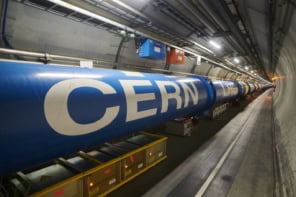
Particle physicists at the Gran Sasso laboratory in Italy have two reasons to celebrate. One is the first ever detection, by the OPERA experiment, of a neutrino that has mutated from another kind of neutrino as it travelled through space. The second achievement is the start-up of the ICARUS detector, which, like OPERA, will study neutrinos that have “oscillated” on their journey from the CERN laboratory outside Geneva in Switzerland.
Neutrinos are chargeless fundamental particles that come in three varieties, or “flavours” – electron, muon and tau. In the 1950s the Italian physicist Bruno Pontecorvo predicted that neutrinos should change, or oscillate, from one flavour to another as they travel through space, a property that would imply neutrinos have mass – in contradiction with the basic formulation of the Standard Model of particle physics. This idea was subsequently supported by experiments that found the Sun to be producing fewer electron neutrinos than had been expected, and by later experiments that detected a shortfall in muon neutrinos produced by cosmic rays interacting in the Earth’s atmosphere.
In these experiments, the phenomenon of oscillation is only inferred indirectly. A reduction in the number of neutrinos from their source to their detection is taken to mean that some of these particles have oscillated to a different flavour of neutrino that cannot be picked up by the detector.
A different approach
OPERA and ICARUS, which are located in the laboratory of the Italian National Institute for Nuclear Physics some 1400 m under the surface of the Gran Sasso mountain in central Italy, take a different approach. Both detectors are designed to make a positive sighting of the tau neutrinos that theory predicts will result from the oscillation of some of the muon neutrinos contained within a beam that is produced at CERN and fired 730 km through the Earth to Gran Sasso. Although physicists believe that the different absence measurements, taken together, constitute very strong evidence for neutrino oscillation, the tau sightings would rule out the slim possibility that the disappearing muon neutrinos are instead decaying or disappearing off into higher dimensions.
The 1250 tonne OPERA instrument, built by a collaboration of around 170 physicists from 12 countries, detects neutrinos using 150,000 ”bricks”, with each brick consisting of many alternating layers of lead and films of nuclear emulsion. These bricks record the tracks of the decay products that result from the interaction of neutrinos with the lead nuclei, each neutrino generating tracks with a distinctive shape. Tau neutrinos produce a charged particle known as a tau lepton, which then decays into a muon, hadron or electron, generating a very short track with a distinctive kink in it.
Weak interaction
The fact that neutrinos interact extremely weakly with normal matter means that only a tiny fraction of the billions of neutrinos in the CERN beam that pass through OPERA every second will leave their mark in the detector. Since it started up in 2006, the experiment has detected a few thousand muon neutrinos but it was not until August 22 last year that it detected its first tau neutrino – on account of the delicate measurement. The researchers say to a confidence of 98% that their signal is due to a tau neutrino. According to OPERA spokesman Antonio Ereditato of the University of Bern in Switzerland, the unambiguous observation of a tau neutrino will require several more events like the one recorded so far. “This might require a few more years,” he says, “but physicists are patient”.
The other news at the Gran Sasso is the opening of another neutrino detector, ICARUS, which uses quite a different detection technique. First proposed in 1977 by Carlo Rubbia, who would go on to share the Nobel prize in 1984 for the discovery of W and Z bosons, this involves filling a tank with a large amount of liquid argon, lining the walls of the tank with planes of wires and then setting up a large potential difference across the tank. Any charged particles passing through the tank create pairs of positively charged ions and electrons as they travel, with those electrons that do not recombine then drifting towards the wire planes where they register a signal. The spatial sequence of signals recreates the path of the charged particles and reveals whether or not those particles were produced by a tau neutrino. ICARUS recorded its first events on 27 May.



